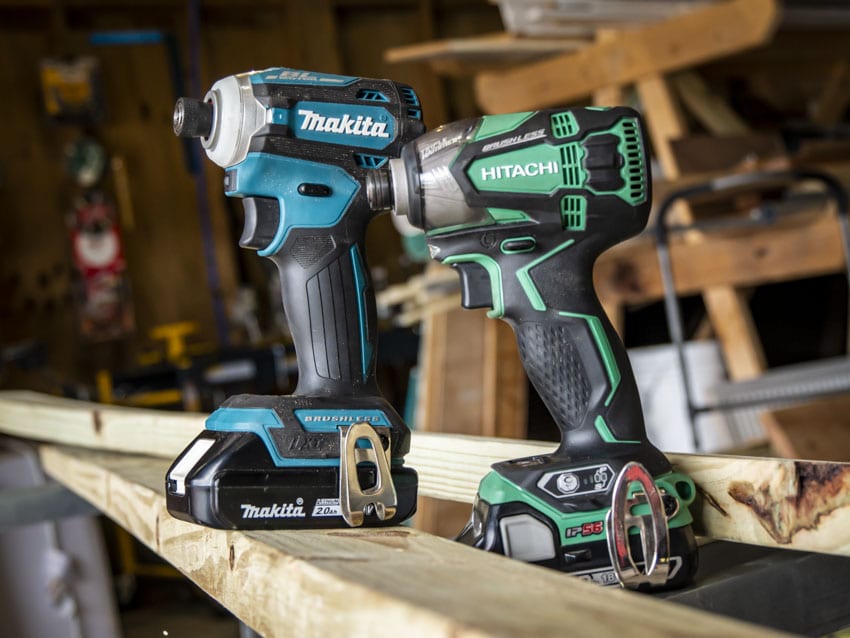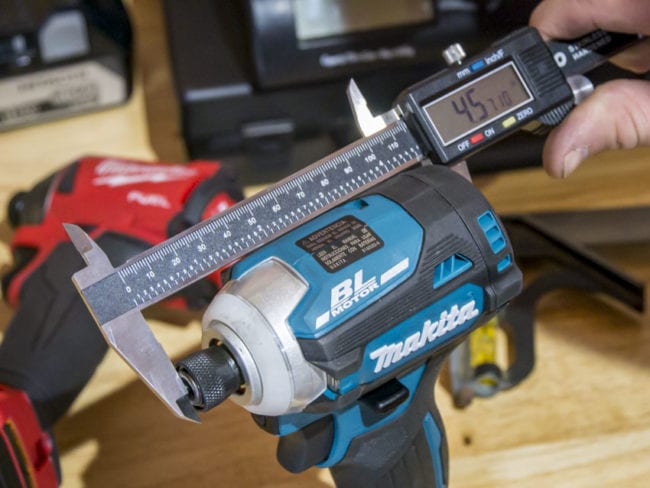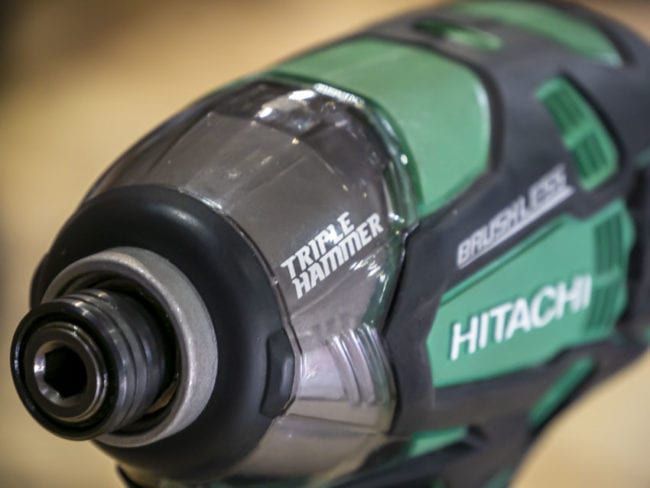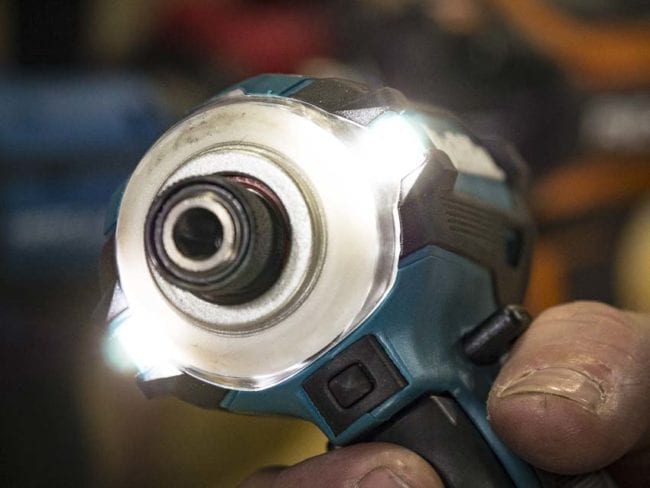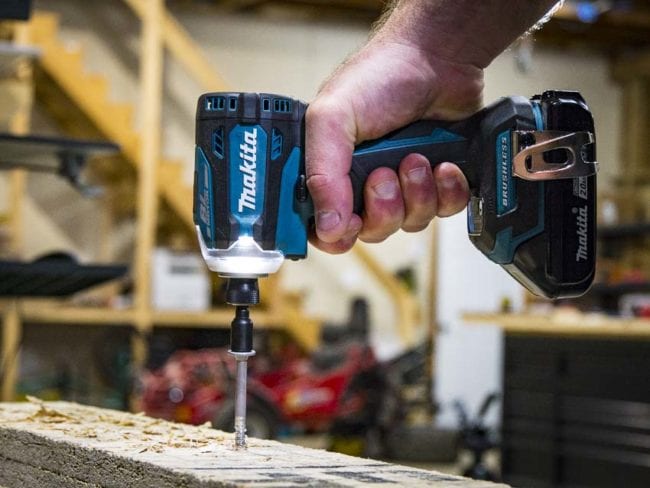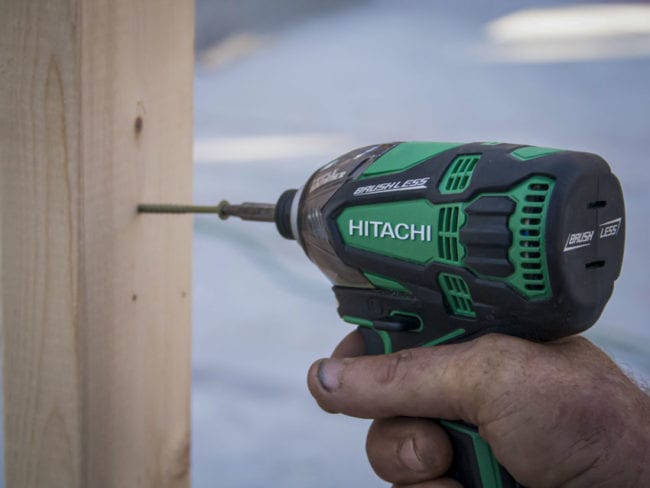Ready for a little Makita Vs Metabo HPT impact driver action? We have two of our favorite models on deck for you. If you ask around our Pro team, the vote is split on simple subjective opinion. So we’re pitting them 1 v 1 to see if we can declare a clear winner.
This is not our average shootout. We go point by point to see how these two 18V impacts compare and call a winner for each test. Just keep in mind that everyone has different priorities. One might rack up more points, but you might find the other fits your needs better.
As always, we welcome your constructive comments and please let us know why you prefer Makita or Metabo HPT when it comes to their flagship impact drivers. Also, keep in mind that while we have invested hundreds of hours collecting head-to-head data, it’s impossible for us to test every possible scenario.
Makita Vs Metabo HPT Impact Driver
Let’s meet today’s competitors.
In the Teal corner, we have the Makita 18V LXT Quick-Shift 4-Speed Brushless Impact Driver
- Model: Makita XDT16
- Power Source: Makita 18V LXT batteries
- No-Load Speed: 0–3600 RPM
- Max Torque: 1600 in-lbs
- Impact Rate: 3800 IPM
Read the standalone review here.
In the Green corner, it’s the Metabo HPT Triple Hammer 18V Brushless Impact Driver
- Model: Metabo HPT WH18DBDL2
- Power Source: Metabo HPT 18V or MultiVolt batteries, Hitachi 18V batteries
- No-Load Speed: 0–3300 RPM
- Max Torque: 1832 in-lbs
- Impact Rate: 4000 IPM
Read the standalone review here.
Metabo HPT originally launched its Triple Hammer impact driver under the Hitachi name before their rebranding. It’s worth noting that it also has a 36V version on their MultiVolt platform. That model specs 2900 RPM (400 less than the 18V), 1859 in-lbs of torque (27 in-lbs more), and 4100 BPM (100 BPM more). It’s also compatible with Metabo HPT’s MultiVolt AC adapter, letting you use corded power if you want.
Read the full MutliVolt Triple Hammer impact driver review here.
Footprint
Both of these impact drivers are definitely on the compact side. Makita’s XDT16 comes in at 4.6″ long and 7.4″ tall without its battery. Metabo HPT’s Triple Hammer sits at 5.0″ long and 7.8″ tall.
Even though Metabo HPT’s footprint is far from oversize, Makita still has a clear advantage. In fact, it has the shortest front-to-back length in the entire 18V class. Milwaukee’s M18 Fuel 2857 is close, just 1mm longer.
Verdict: Makita
Weight
We measured both impact drivers on a digital scale bare and with their compact batteries. Makita’s compact pack is a 2.0Ah and Metabo HPT’s is a 3.0Ah.
Makita weighs in at 1.99 pounds bare and 2.85 with its battery. Metabo HPT is super-close at 2.02 pounds bare and 2.90 pounds with its battery.
With a weight difference of less than an ounce, this one’s a tie.
Verdict: Tie
Feature Set
Both of these impact drivers cover the feature set basics, but what about going further?
- Motor: Both tools have brushless motors.
- Hammer and Anvil: Makita has a traditional 2-hammer system specially designed by the product team. Metabo HPT uses a 3-hammer system. They’re the only brand we’ve seen go with a third hammer.
- Collet: Makita has one-hand bit insertion but no spring ejection. Metabo HPT doesn’t have either one.
- Battery: Both models use slide-style batteries. (We’ll get into the capacity difference later)
- Speeds: Both tools use electronic speed controls. Makita has 4 speeds plus four assist modes and a two-mode programmable button. Metabo HPT has 3 speeds and an assist mode.
- LED light: Makita uses 2 LEDs on either side of the collet. Metabo HPT sticks with one LED below the collet.
Metabo HPT moves forward from the basics by using a 3-hammer system (hence the Triple Hammer name). We’ll see how much of a difference that makes in the performance tests. Makita takes the XDT16’s electronic control further than anyone else aside from customizable app-based controls.
You can make the argument that one feature or the other is more relevant, but it really depends on what jobs are on your plate. In the end, Makita gains a couple of extra points with their LED light and collet designs to take a close win.
Verdict: Makita
Power
We have two ways to test impact driver power. In our fastening test, each impact driver fastens a hardened nut onto a bolt and we use a digital torque wrench to measure how much force it requires to break it.
This test method does not give the same results as the manufacturer’s specification testing since rating impact driver torque isn’t an exact science.
It takes an average of 2131 in-lbs of torque to break what Makita’s XDT16 fastens. On the other hand, it takes 1982 in-lbs to break the Metabo HPT Triple Hammer’s efforts.
In our second test, we proof-load the same hardened nuts to specific intervals and see how much breaking force (nut-busting torque) each impact driver has.
Here, Makita breaks 3300 in-lbs (206.25 ft-lbs) and Metabo HPT is still behind at 2760 in-lbs (172.5 ft-lbs).
Despite having lower torque on its spec sheet, Makita shows more measurable fastening and breaking force than Metabo HPT in this test.
Verdict: Makita
Fastening Speed
With impact drivers, we’re willing to run fasteners up to ledger screws or timber screws before turning to an impact wrench for more power. Using 1/4″ ledger screws, we measure the RPMs each impact driver can maintain.
Metabo HPT puts in a fine effort, averaging 573 RPM. However, Makita leads the entire field in this test at 651 RPM. Metabo HPT is the second fastest we’ve tested, so it’s no slouch here.
Verdict: Makita
Fastening Efficiency
Fastening efficiency is a measure of how hard the motor has to work under load. The closer its RPMs are to the no-load speed we tested while fastening, the less strain the motor is under.
In the same ledger screw test, Makita maintains 21% of its tested no-load speed. Metabo HPT’s 24% gives the Green team the win.
It’s worth noting here that both of these impact drivers tested significantly lower no-load speeds than their specifications. Makita was 500 RPM lower and Metabo HPT was 915 RPM lower. Both tools pick up some speed if you put a larger battery in it, but they’re still short of their claims.
Verdict: Metabo HPT
Available Batteries
If you want to expand beyond the batteries that come in your kit, particularly for longer runtime, it’s helpful to know what’s available.
Makita’s 18V LXT line has several 1P and 2P packs available (1P = 1 set of 5 lithium-ion cells, 2P = 2 set of 5 lithium-ion cells).
- 2.0Ah (1P)
- 3.0Ah (2P)
- 4.0Ah (2P)
- 5.0Ah (2P)
- 6.0Ah (2P)
Metabo HPT’s range gives you a bit more flexibility thanks to its MultiVolt battery compatibility.
- 1.5Ah (1P)
- 2.5Ah (1P)
- 3.0Ah (1P)
- 4.0Ah (2P)
- 5.0Ah (2P)
- 6.0Ah (2P)
- 8.0Ah MultiVolt (2P)
Both brands have some older batteries still running around or kitted with tools that aren’t as common as others. What tips the scale to Metabo HPT is the compatibility with MultiVolt batteries, giving you an 8.0Ah capacity if you need it.
Hitachi 18V batteries also work with Metabo HPT tools. However, Metabo HPT’s 18V batteries aren’t forward compatible with their 36V MultiVolt tools.
Makita has a big benefit as well. Its 18V batteries power more powerful 18V X2 (36V) tools without the need for a different battery. The upcoming 40V max XGT line will be a different platform, though.
Verdict: Metabo HPT
Compatible Tools
Makita currently has an incredibly deep line of some 225 tools that work with its 18V LXT battery. Metabo HPT doesn’t have nearly as many individual products, but its line is deep enough to cover most of the tools Pros need on the cordless side.
Verdict: Makita
Price
You can buy each of these tools bare or with batteries and a charger. We encourage you to shop around to get the best deal. We price check Acme Tools, Home Depot, and Lowe’s. You can find both on Amazon as well.
Makita 18V Impact Driver
- XDT16Z Bare tool: $179
- XDT16R Kit with two 2.0Ah batteries: $299
- XDT16T Kit with two 5.0Ah batteries: $359
Metabo HPT Triple Hammer Impact Driver
- WH18DBDL2Q4M Bare tool: $179
- WH18DBDL2M Kit with two 3.0Ah batteries: $269 (several retailers are currently running under the $389 list price)
These two impact drivers are running neck and neck on their bare tool prices with Metabo HPT gaining an advantage in its kit price. It comes with two 3.0Ah compact batteries, so it has more capacity than Makita’s 2 x 2.0Ah kit. However, Metabo HPT’s list price is $90 more than Makita’s. Current pricing looks better for Metabo HPT, but we’re not sure how long it will last.
It’s also worth noting that Metabo HPT does not have a 5.0Ah or 6.0Ah kit available.
Verdict: Metabo HPT
Warranty
Makita has a 3-year warranty on their tools and batteries. Metabo HPT gives you a year less on the batteries but warranties their lithium-ion tools for life. This one’s a no-brainer.
Verdict: Metabo HPT
Final Verdict
In this Makita vs Metabo HPT impact driver Pro Tool Reviews Thursday Throwdown, Makita comes away with a close win, 5-4 (1 tie). And without a dominating performance by either tool, the division among our team still exists.
Grab the Makita XDT16 impact driver if you want the best combination of performance and size to go along with an ultra-deep line of compatible tools.
Grab the Metabo HPT Triple Hammer impact driver if you want solid performance with a better price and warranty program.

